Instruction
How the direction of turn influences your swing
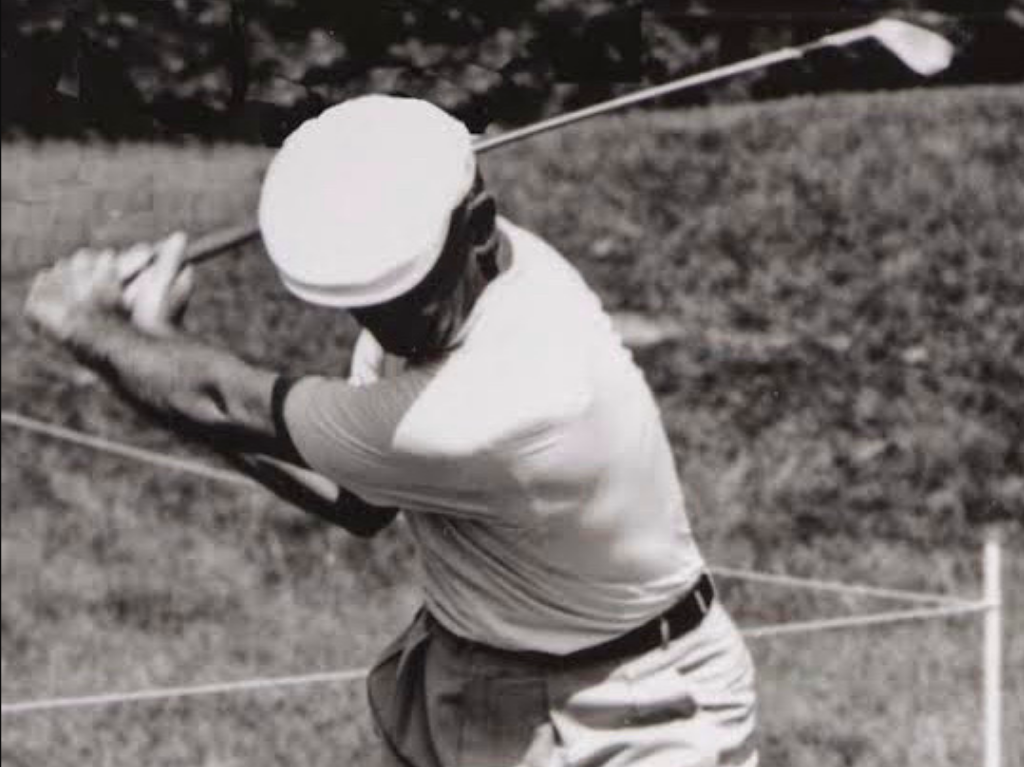
Understanding the direction you turn in the backswing will help identify your swing pattern. To start, turn is simply a word for something going around or moving circularly. When teaching, the term turn is very broad. The spine, shoulders and pelvis can all move in different directions.
So what direction should you turn? After an efficient setup (How Posture Influences Your Swing) I want players to coil around their original spine angle. This gives players an efficient “shape” to the body at the top of the backswing. Shape is the relationship between the upper and lower half of the body. Shape retains body angles from the setup, which also mirror impact. The relationship between the upper and lower body are highlighted in the pictures below.
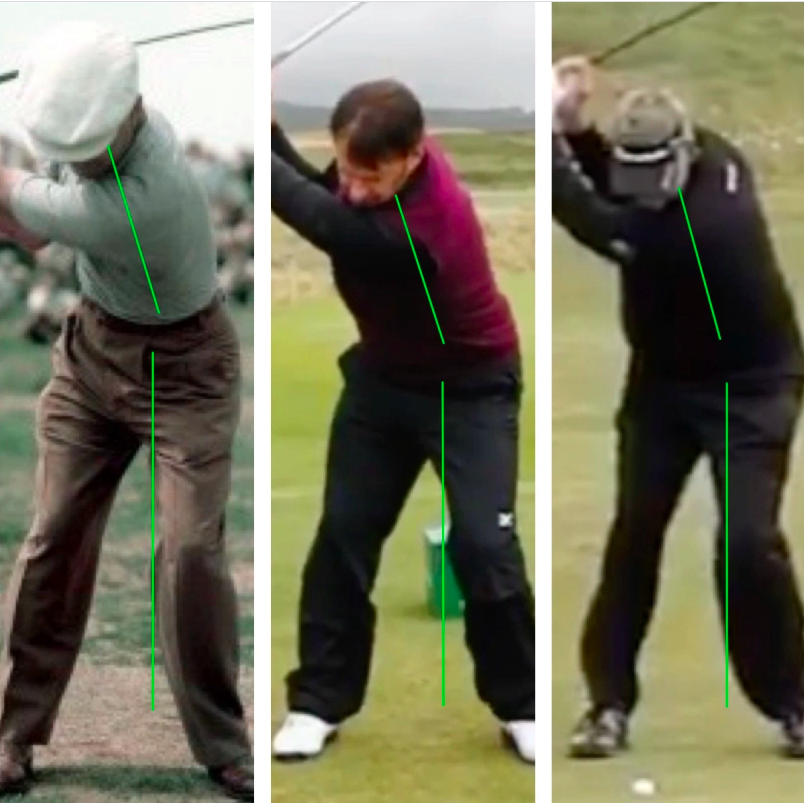
When in this shape, the downswing can become a reaction towards the target. The club and body can return to impact with efficiency and minimal timing required. The body doesn’t need to find the impact position. This impact position is a common look to all great ball-strikers.
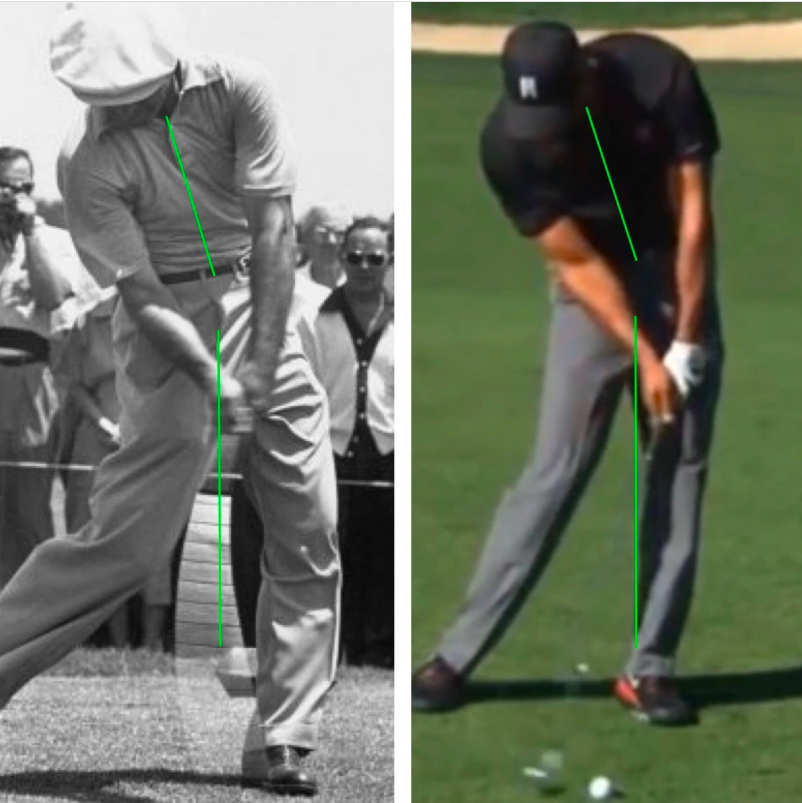
An important concept to understand is the direction of turn is more important than the amount of turn. Think of throwing a ball towards a target. You don’t turn more to throw the ball further or for more accuracy. Your body coils the correct direction to go forward and around towards the target. The golf swing and direction of turn is similar to a throwing position.
A great drill to get the feeling of this coil is what I call off the wall on the wall. Start by setting up with your lead side against a wall. Make sure your trail shoulder is below the lead shoulder with a tucked trail arm. From this position, swing your arms to the top of your swing. Note the backswing position.
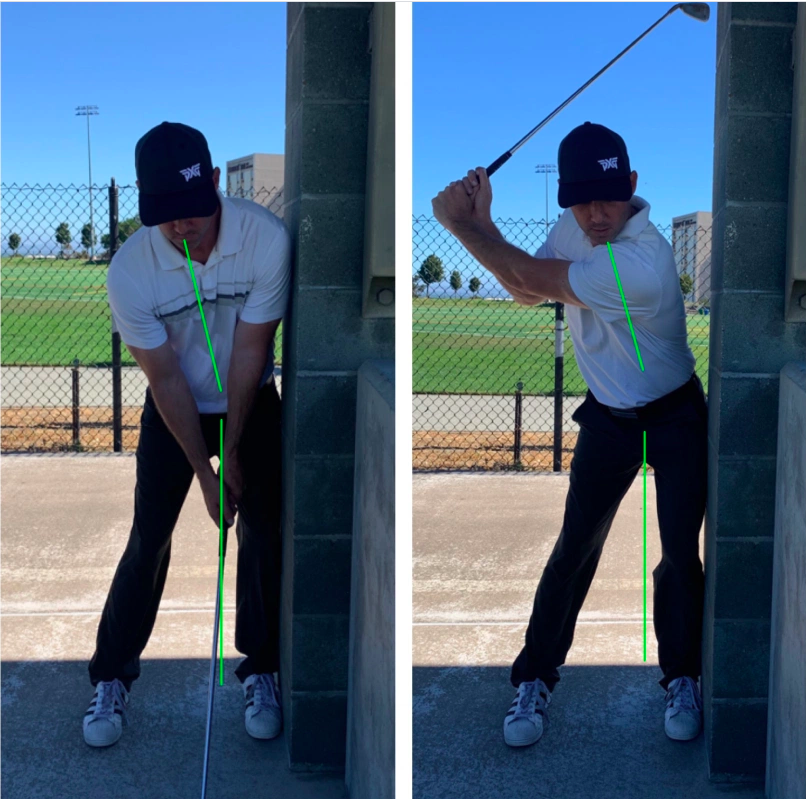
When doing this drill, note how your upper body moves off the wall, and the lower body stays on the wall. An important note to make is the hips and glutes don’t stay stagnant against the wall. They go around, sliding against the wall as the upper moves off.
The beauty of the golf swing is there is more than one way to do it. Many great players turn with lead side bend in the backswing. This is where the upper body tilts towards the target (lateral trunk flexion). However, these players will have to change their spine angle to find impact. This pattern isn’t incorrect, just needs more recovery in the downswing to find the impact position.
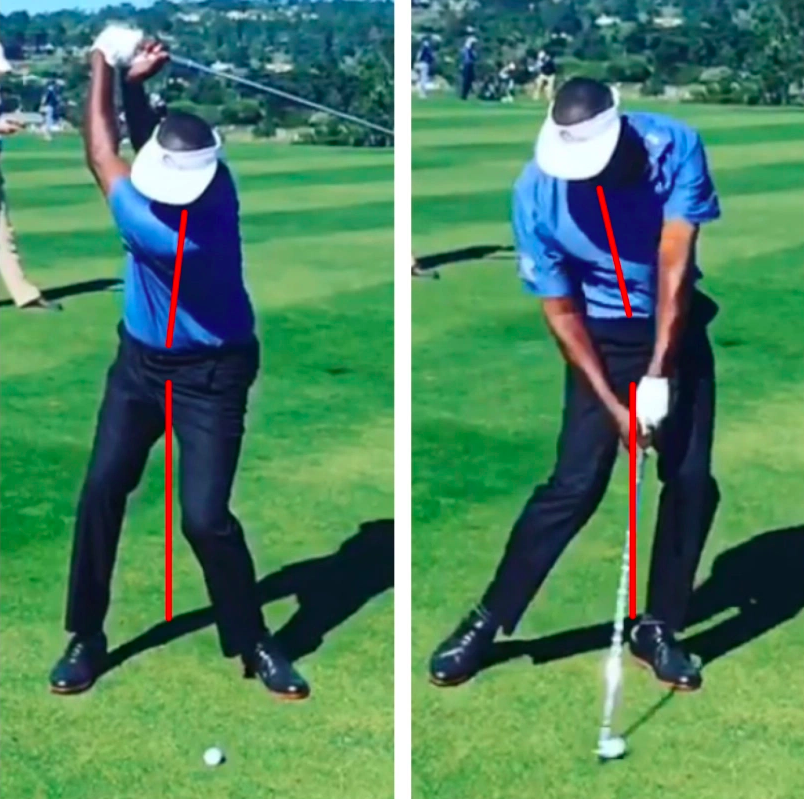
I do not prefer players having to recover in their downswing. I define recovery as having to re-position the body in the downswing to find impact. Think of a baseball player having to throw a ball to first base when his body starts in a contorted position. I the golf swing, this requires more talent and timing and can lead to inconsistency unless precisely practiced and trained.
Educating yourself on how your body coils in the backswing is critical when working on your swing. Remember, there is no one perfect swing and people have different physiologies. However, coil in a direction that will give you the most efficient swing and prevent injuries.
- LIKE98
- LEGIT13
- WOW1
- LOL3
- IDHT2
- FLOP3
- OB3
- SHANK14
Instruction
Clement: Laid-off or perfect fade? Across-the-line or perfect draw?

Some call the image on the left laid off, but if you are hitting a fade, this could be a perfect backswing for it! Same for across the line for a draw! Stop racking your brain with perceived mistakes and simply match backswing to shot shape!
- LIKE0
- LEGIT0
- WOW0
- LOL0
- IDHT0
- FLOP0
- OB0
- SHANK1
Instruction
The Wedge Guy: The easiest-to-learn golf basic

My golf learning began with this simple fact – if you don’t have a fundamentally sound hold on the golf club, it is practically impossible for your body to execute a fundamentally sound golf swing. I’m still a big believer that the golf swing is much easier to execute if you begin with the proper hold on the club.
As you might imagine, I come into contact with hundreds of golfers of all skill levels. And it is very rare to see a good player with a bad hold on the golf club. There are some exceptions, for sure, but they are very few and very far between, and they typically have beat so many balls with their poor grip that they’ve found a way to work around it.
The reality of biophysics is that the body moves only in certain ways – and the particulars of the way you hold the golf club can totally prevent a sound swing motion that allows the club to release properly through the impact zone. The wonderful thing is that anyone can learn how to put a fundamentally sound hold on the golf club, and you can practice it anywhere your hands are not otherwise engaged, like watching TV or just sitting and relaxing.
Whether you prefer an overlap, interlock or full-finger (not baseball!) grip on the club, the same fundamentals apply. Here are the major grip faults I see most often, in the order of the frequency:
Mis-aligned hands
By this I mean that the palms of the two hands are not parallel to each other. Too many golfers have a weak left hand and strong right, or vice versa. The easiest way to learn how to hold the club with your palms aligned properly is to grip a plain wooden ruler or yardstick. It forces the hands to align properly and shows you how that feels. If you grip and re-grip a yardstick several times, then grip a club, you’ll see that the learning curve is almost immediate.
The position of the grip in the upper/left hand
I also observe many golfers who have the butt of the grip too far into the heel pad of the upper hand (the left hand for right-handed players). It’s amazing how much easier it is to release the club through the ball if even 1/4-1/2″ of the butt is beyond the left heel pad. Try this yourself to see what I mean. Swing the club freely with just your left hand and notice the difference in its release from when you hold it at the end of the grip, versus gripping down even a half inch.
To help you really understand how this works, go to the range and hit shots with your five-iron gripped down a full inch to make the club the same length as your seven-iron. You will probably see an amazing shot shape difference, and likely not see as much distance loss as you would expect.
Too much lower (right) hand on the club
It seems like almost all golfers of 8-10 handicap or higher have the club too far into the palm of the lower hand, because that feels “good” if you are trying to control the path of the clubhead to the ball. But the golf swing is not an effort to hit at the ball – it is a swing of the club. The proper hold on the club has the grip underneath the pad at the base of the fingers. This will likely feel “weak” to you — like you cannot control the club like that. EXACTLY. You should not be trying to control the club with your lower/master hand.
Gripping too tightly
Nearly all golfers hold the club too tightly, which tenses up the forearms and prevents a proper release of the club through impact. In order for the club to move back and through properly, you must feel that the club is controlled by the last three fingers of the upper hand, and the middle two fingers of the lower hand. If you engage your thumbs and forefingers in “holding” the club, the result will almost always be a grip that is too tight. Try this for yourself. Hold the club in your upper hand only, and squeeze firmly with just the last three fingers, with the forefinger and thumb off the club entirely. You have good control, but your forearms are not tense. Then begin to squeeze down with your thumb and forefinger and observe the tensing of the entire forearm. This is the way we are made, so the key to preventing tenseness in the arms is to hold the club very lightly with the “pinchers” — the thumbs and forefingers.
So, those are what I believe are the four fundamentals of a good grip. Anyone can learn them in their home or office very quickly. There is no easier way to improve your ball striking consistency and add distance than giving more attention to the way you hold the golf club.
More from the Wedge Guy
- The Wedge Guy: Golf mastery begins with your wedge game
- The Wedge Guy: Why golf is 20 times harder than brain surgery
- The Wedge Guy: Musings on the golf ball rollback
- LIKE86
- LEGIT13
- WOW6
- LOL1
- IDHT0
- FLOP4
- OB1
- SHANK8
Instruction
Clement: Stop ripping off your swing with this drill!

Not the dreaded headcover under the armpit drill! As if your body is defective and can’t function by itself! Have you seen how incredible the human machine is with all the incredible feats of agility all kinds of athletes are accomplishing? You think your body is so defective (the good Lord is laughing his head off at you) that it needs a headcover tucked under the armpit so you can swing like T-Rex?
- LIKE0
- LEGIT2
- WOW2
- LOL0
- IDHT0
- FLOP0
- OB0
- SHANK2
-

 19th Hole2 weeks ago
19th Hole2 weeks agoDave Portnoy places monstrous outright bet for the 2024 Masters
-

 19th Hole3 days ago
19th Hole3 days agoJustin Thomas on the equipment choice of Scottie Scheffler that he thinks is ‘weird’
-

 19th Hole2 weeks ago
19th Hole2 weeks agoTiger Woods arrives at 2024 Masters equipped with a putter that may surprise you
-

 19th Hole3 days ago
19th Hole3 days ago‘Absolutely crazy’ – Major champ lays into Patrick Cantlay over his decision on final hole of RBC Heritage
-

 19th Hole2 weeks ago
19th Hole2 weeks agoTwo star names reportedly blanked Jon Rahm all week at the Masters
-

 19th Hole1 week ago
19th Hole1 week agoReport: LIV Golf identifies latest star name they hope to sign to breakaway tour
-

 19th Hole1 week ago
19th Hole1 week agoNeal Shipley presser ends in awkward fashion after reporter claims Tiger handed him note on 8th fairway
-

 19th Hole1 week ago
19th Hole1 week agoBrandel Chamblee has ‘no doubt’ who started the McIlroy/LIV rumor and why
















Robert Johansson
Dec 31, 2020 at 6:23 am
All players show compensational impacts positions
geohogan
Nov 4, 2020 at 5:36 am
Muscles do not stretch or coil.
Bone and muscle create levers.
The kinematic sequence explains how acceleration
of the clubhead is result of deceleration of proximal
to distal in sequence;
not uncoiling of muscles, as if coil springs: an absurd, incorrect
image, leading to many injury.
geohogan
Nov 4, 2020 at 5:31 am
We stand on two legs, supported by two hip joints.
A turn is around a central point. In golf swing we pivot first in BS, on the right hip joint(right hand swingers) and left hip joint in follow through.
Attempting to rotate or turn is cause of injury to knee and lower back.
Richard Grime
Jan 25, 2021 at 3:51 pm
Well said Sir!
PSG
Sep 27, 2020 at 11:38 am
This is a great article.
That said, avoid words like “all”. There are great ball strikers – Henrick Stenson – who come off the wall with their lower body. In golf, somebody has probably made it work somewhere.
But other than a few “all”s that should be “most”s, this article will help a lot of people and is great knowledge.
Tyler Durden
Sep 27, 2020 at 12:58 pm
He said, “ This impact position is a common look to all great ball-strikers.”
But thanks for your comment, it made me read the article a few times to more understand what the author was trying to say.
Paulo
Sep 27, 2020 at 4:16 pm
Hi Tyler. Thanks for your valued input. Keep up the good work from all of us here.